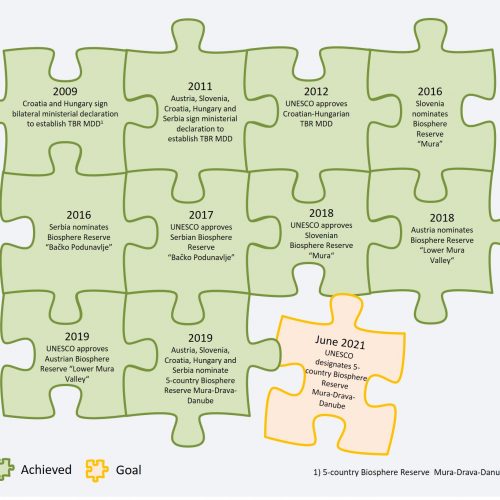News
World’s first ‘5-country biosphere reserve’ nominated
Paving the way for Europe’s largest river sanctuary – 930,000 hectares of natural treasures between Austria and Serbia nominated to UNESCO for protection – ‘Amazon of Europe’ becomes an international model region for nature conservation and sust
Vienna/ Zagreb/ Budapest/ Ljubljana/ Belgrade, 30th of September 2019 – Today, thirty years after the fall of the Iron Curtain, Austria, Slovenia, Croatia, Hungary and Serbia submitted a historic UNESCO application to establish the first ‘5-country biosphere reserve’ in the world. With a total area of around 930,000 hectares and a length of 700 kilometres, the shared nature and wildlife along the Mura, Drava and Danube rivers will become Europe’s largest river protection area. The so-called ‘Amazon of Europe’ begins at the Austrian Mura River and extends over the Drava to the Danube in Serbia. Until 1989, the river landscape had been torn apart by the Iron Curtain. "This landmark cross-border nomination is a powerful demonstration of a shared green vision that builds on, and reinforces both regional cooperation and unity in Europe. It is a significant step forward in protecting the region’s natural treasures and serves as a striking example of how nature conservation can bring countries together”, says Andreas Beckmann, CEO of WWF CEE [replace with your spokesperson]. The designation of the ‘5-country biosphere reserve’ by UNESCO is expected in June 2020.
The basis for the nomination was forged in 2011. The environment ministers of all five countries signed a joint declaration committing themselves to establish the trans-border biosphere reserve. In 2012, the riverine areas in Croatia and Hungary were granted biosphere reserve status, soon followed by Serbia (2017), Slovenia (2018) and Austria (2019). The joint nomination connects all five pieces into one coherent protected area. The strictly protected core and buffer zone, which consists of 13 major single protected areas, amounts to 280,000 hectares. It is surrounded by 650,000 hectares of transitional zone.
With its rare floodplain forests, gravel and sand banks, river islands, and oxbows, the area offers a unique natural and cultural landscape. The ‘Amazon of Europe’ is home to Europe’s highest density of breeding white-tailed eagle, with more than 140 pairs, as well as endangered species such as the little tern, black stork, otters, beavers and sturgeons. It is also an important resting and feeding place for more than 250,000 migratory birds every year. “Five countries have agreed to jointly protect an area which is one of the richest in terms of species diversity in Europe. Such floodplain areas are only surpassed by tropical rainforests”, says Arno Mohl, programme leader at WWF Austria and long-time campaigner for the protection of the Mura, Drava and Danube Rivers.
Model region for nature conservation and sustainable regional development
The region’s identity as well as the livelihoods of almost 900,000 inhabitants living in the biosphere reserve highly depend on the Mura, Drava and Danube lifelines. Intact floodplains protect settlements from floods and ensure clean drinking water supplies, whereas spectacular landscapes enhance the potential for sustainable tourism development. “In times of the climate crisis and the vast extinction of species, it becomes a matter of survival to protect our last natural areas. The new biosphere reserve is an important step away from nature exploitation such as destructive hydropower dam or sediment extraction projects. It paves the way for a sustainable coexistence of people and nature”, says Mohl.
In parallel to the submission of the ‘5-country biosphere reserve’, additional projects for nature and people are already being implemented in the area. These have a combined funding of around 14 million euros and are co-financed by the European Union. Within the initiative ‘coop MDD’, the protected area administrations of the Mura-Drava-Danube region have been cooperating since 2017 to jointly focus on common goals and trans-border nature protection measures. In June 2019, the ‘Amazon of Europe Biketrail’ project started. By 2021, sports and nature enthusiasts will be able to book cycling tours, including excursions to local natural and cultural sights, along with services such as luggage transport. Furthermore, river revitalizations will be implemented to create new natural habitats and recreational areas for people to truly experience the stunning landscape along the rivers.
The protected area was nominated with considerable help of WWF, EuroNatur, and many local conservation partners in all five countries. “For more than 20 years, WWF has invested a great deal to achieve a better protection of the rivers’ natural values. We are very proud of the achievement of this joint nomination which will preserve the unique Mura-Drava-Danube rivers for us and future generations”, concludes Mohl.
Alongside WWF, the ministries and nature protection authorities of Austria, Slovenia, Croatia, Hungary and Serbia, as well as MAB (Man and the Biosphere) committees, participated in the preparation of the UNESCO nomination dossier.
